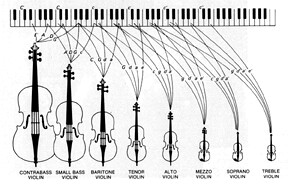 Bass Blog reader Trevor Bortins sent me a link to this very interesting site about the “new” violin family known as the the violin octet. I have done some reading and heard some musical examples regarding this set of acoustically well-proportioned instruments, and the logic behind these instruments is quite clear. Invented in the early 20th century as a result of physicist Frederick A. Saunders’ research into violin acoustics, the instruments that make up the “violin family” share the same acoustical traits:
Bass Blog reader Trevor Bortins sent me a link to this very interesting site about the “new” violin family known as the the violin octet. I have done some reading and heard some musical examples regarding this set of acoustically well-proportioned instruments, and the logic behind these instruments is quite clear. Invented in the early 20th century as a result of physicist Frederick A. Saunders’ research into violin acoustics, the instruments that make up the “violin family” share the same acoustical traits:
The eight instruments form a family with basic traits in common, but each member has its own individual personality. The homogeneity of sound is the result of adjustments in body length and other physical characteristics so that each instrument has its so-called main wood resonance and main air resonance near the two open middle strings (as is the case with the Heifetz Guarnerius violin). In the five higher instruments – Treble, Soprano, Mezzo, Alto, Tenor – the main wood resonance lies near the open second string, and the main air, or Helmholtz, resonance lies near the open third string. In the three lower instruments – Baritone, Small Bass, and large Contrabass – the Helmholtz air resonance is placed several semitones lower to suit the preferences of many performers. Experimental musical evaluation of the Octet in England has, however, indicated a preference for the higher placement of the Helmholtz resonance in the lower instruments so as to give a lighter, more balanced consort sound. A Tenor and a Baritone have been built this way.
You can read more about this family of instruments at the new violin family website.
The range of these instruments is displayed on the following chart. Click the links below to learn more about any individual member of this family of instruments:
Treble Violin • Soprano Violin • Mezzo Violin • Alto Violin
Tenor Violin • Baritone Violin • Small Bass • Contrabass
It is quite interesting to check out the instruments that fall in between the sizes of standard stringed instruments. The baritone violin and small bass are of particular interest to me, and the contrabass is quite formidable in shape. Thumb position must be next to impossible on this massive violin. You can check out some active violin octet ensembles by following this link.
These instruments have been embraced by many players of traditional stringed instruments. Here are some quotes from well-known string players regarding the violin octet:
Yo-Yo Ma, Cellist
“It was an amazing experience to play the Bartok Viola Concerto on the Alto Violin.”
(Available on the CD “The New York Album,” which won a 1995 Grammy)
Roderick Skeaping, London, Violinist/Composer
“I sense a genuine excitement about the new possibilities the Violin Octet has created for string sound.”
Vladistav Chernushenko, President, St. Petersburg Conservatory
“American octet violins sound very expressively in different instrumental combinations. The Octet can be perfectly matched with the human voice as well as various wind instruments.”
Hans Astrand, Secretary, Royal Swedish Academy of Music
“A remarkable development of orchestral instruments, and one of the few times that a consistent theory of acoustics has been applied to a whole family of instruments.”
Dmitri Tchasovitin, Director, St. Petersburg Charity Foundation
“The sound of the octet creates wonderfully unprecedented tonal combinations. The whole palette of the timbre, colors, and dynamics of the octet faces the 21st Century.”
Related Posts:
- Violinmasterclass.com – great resource for string players
- Yo-Yo Ma a sellout?
- Handel-Halvorsen concert video
- Classical music industry death throes
- Maddening audition story
Bass News Right To Your Inbox!
Subscribe to get our weekly newsletter covering the double bass world.



you know alot about music! this is great, helped me out! 🙂
awesome! I have to do a project about the violin family, and this really helps!